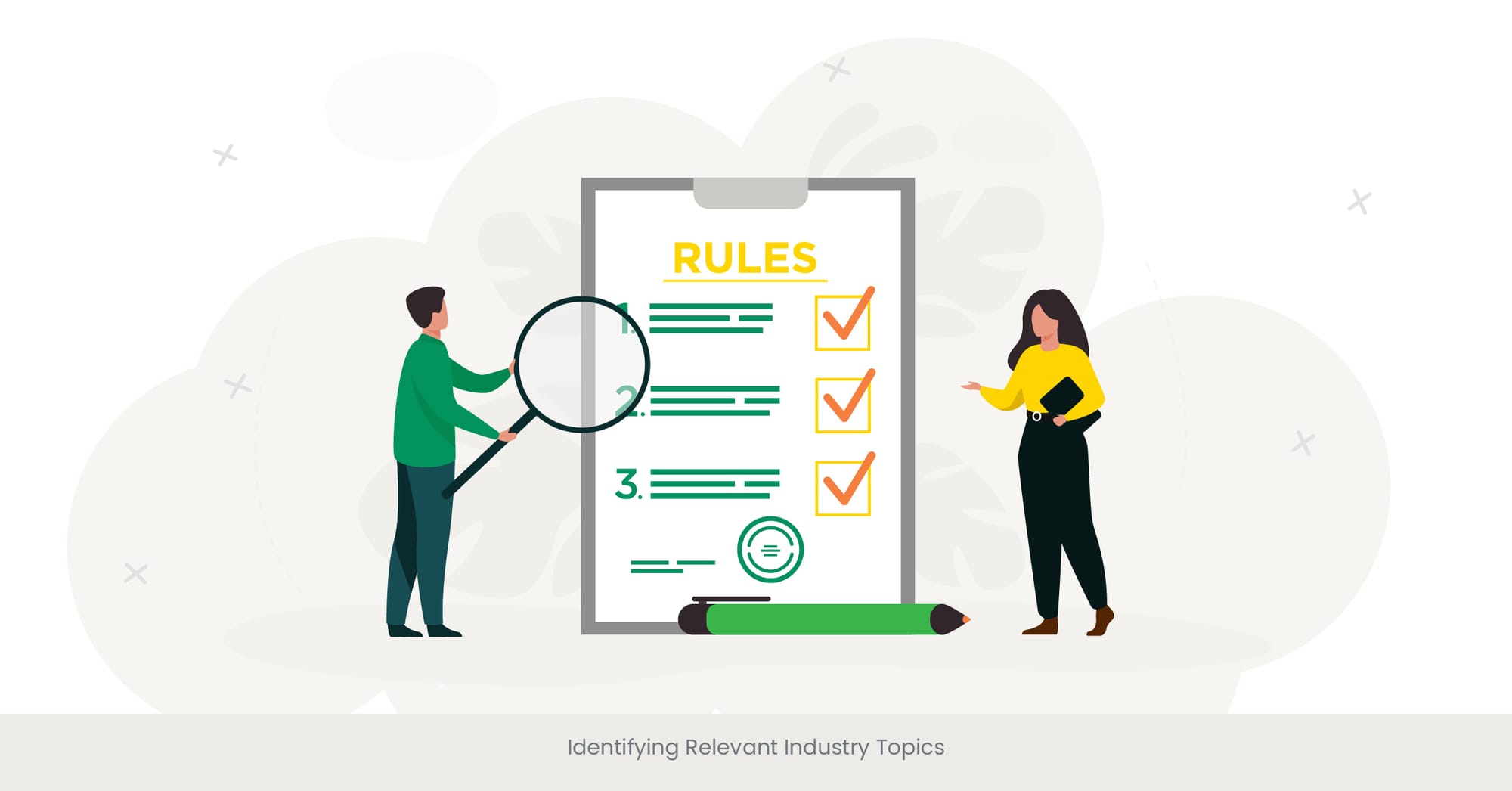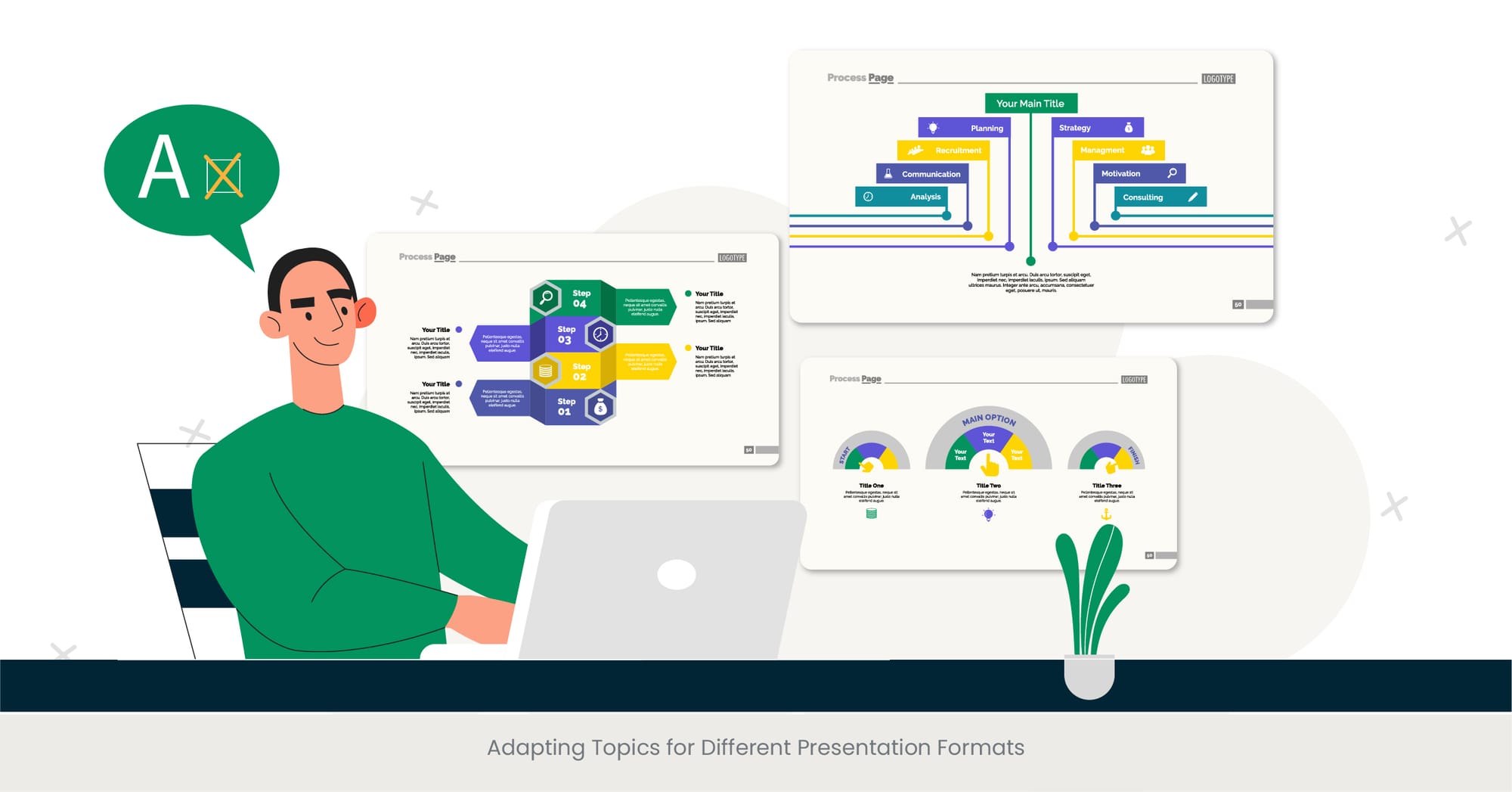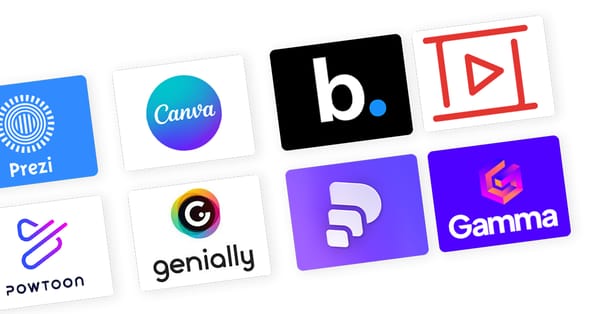
Identifying Relevant Industry Topics

Introduction to Identifying Relevant Industry Topics
In the world of professional business presentations, the importance of selecting relevant industry topics cannot be overstated. A well-chosen topic not only captures the audience's attention from the very beginning but also ensures that your presentation resonates with the listeners' interests and needs. Identifying relevant topics is the first step toward creating a successful business presentation that engages and informs. This process involves understanding your audience, the current industry landscape, and how specific topics can align with your business goals to make a lasting impact.
The process of identifying relevant industry topics requires a keen understanding of both the market and the audience you aim to address. A topic that seems pertinent on the surface might not engage your audience if it does not align with their interests or needs. Historical trends, current market analysis, and foresight into future developments play a critical role in this selection process. By integrating these elements, presenters can choose topics that are not only current but also have a lasting appeal, ensuring that the presentation remains impactful long after it has concluded.
Real-World Application and Examples
For instance, a business presentation targeting technology entrepreneurs might focus on emerging technologies, cybersecurity threats, or the impact of remote work on corporate culture. These topics are not only timely, given the current technological advancements and challenges, but they also directly relate to the daily operations and strategic planning of tech businesses. By highlighting recent examples, such as a case study on a company that successfully navigated cybersecurity threats, presenters can illustrate the practical applications of these topics in corporate presentations and demonstrate their relevance to the audience’s interests and business objectives.
Supporting the selection of relevant topics with data and research adds credibility to your presentation. According to a survey conducted by the Business Presentation Association, presentations that focus on industry-relevant topics are 50% more likely to capture and retain audience attention compared to those that do not. Furthermore, incorporating statistics and findings from authoritative sources, such as industry reports or academic studies, helps validate the importance of the chosen topics. For example, referencing a study on the adoption of remote work practices can provide a solid foundation for discussing the impact of technology on corporate culture.
Trendspotting in Business Presentation Topics

Exploring the Horizon: The Importance of Trendspotting
In crafting a professional business presentation, the ability to spot and leverage emerging trends can set you apart from the competition. Trendspotting involves identifying the waves of change within your industry and using this insight to inform the focus of your presentation. This proactive approach ensures that your content is not only relevant but also forward-thinking, providing your audience with valuable insights into future challenges and opportunities. By staying ahead of the curve, you can position your presentation as a source of thought leadership, capturing your audience's interest and establishing credibility from the outset.
At the heart of trendspotting lies rigorous research and analysis. This includes reviewing industry reports, analyzing market data, and staying updated with news and developments. Understanding the trajectory of your industry enables you to predict which topics will resonate most strongly with your audience. For example, in the tech industry, keeping an eye on innovations in artificial intelligence and machine learning can help you anticipate shifts in business operations and customer engagement strategies. This background work is essential for identifying trends that are not just passing fads but have the potential to significantly impact the industry.
Bringing Trends to Life: Case Studies and Examples

Illustrating trends with real-world examples breathes life into your presentation. Discussing how pioneering companies are adopting new technologies or business models provides tangible evidence of the trend's impact and applicability. For instance, showcasing a business that has successfully integrated AI to enhance customer service can demonstrate the practical benefits of embracing new technologies. These examples not only make your presentation more engaging but also help your audience visualize how they can apply these insights to their own businesses.
To reinforce the significance of the trends you've identified, it's crucial to back your observations with data and expert opinions. Incorporating statistics from reputable sources, such as industry associations or academic research, adds weight to your arguments. Additionally, quoting thought leaders who have commented on these trends can lend an authoritative voice to your presentation. For instance, citing a study forecasting the growth of the AI market over the next decade can provide a compelling reason for businesses to pay attention to this trend.
Customizing Topics for Specific Audiences

Tailoring Your Message: The Key to Engagement
When it comes to delivering a killer business presentation, the one-size-fits-all approach falls short. Customizing your topic for specific audiences is crucial in ensuring that your message resonates deeply and maintains the audience's attention throughout your presentation. This customization involves a thorough analysis of your audience's demographics, interests, challenges, and goals. By tailoring your presentation to address these specific aspects, you can create a more engaging and impactful experience that speaks directly to the concerns and aspirations of your listeners.
The foundation of effectively customizing your presentation topics lies in a deep understanding of your audience. This involves gathering data on the audience members' industry roles, their level of expertise, and what they hope to gain from your presentation. Are they looking for strategic insights, operational tactics, or a glimpse into future trends? For instance, a presentation to potential investors will differ significantly from one aimed at technical experts. While investors may be interested in business models and market potential, technical audiences might prefer in-depth discussions on product innovation and implementation challenges.
Real-World Customization: Examples and Strategies

Illustrating the power of customization, consider a presentation on digital marketing strategies. For a startup audience, focusing on cost-effective tactics and tools for audience engagement might be most relevant. In contrast, for a corporate audience, the emphasis might be on integrating digital marketing into broader marketing strategies and measuring ROI. By presenting case studies or examples that reflect the specific contexts and challenges of your audience, you can demonstrate a clear understanding of their needs and how they can apply your insights to achieve their objectives.
Incorporating insights from external sources can significantly enhance the relevance of your business presentation examples. Surveys indicating the primary concerns of different industry segments, reports on audience engagement strategies, and statistics on the effectiveness of customized content can all provide a solid basis for your approach. For example, citing a study showing a 30% increase in audience engagement for presentations tailored to specific audience needs can convincingly argue for the importance of customization in business presentations.
Strategies for Aligning Topics with Business Goals

Harmonizing Objectives: The Strategic Alignment
In the realm of professional business presentations, aligning the topic with your company's strategic goals is crucial for conveying a cohesive and compelling message. This alignment ensures that every presentation serves a purpose beyond merely informing or entertaining; it becomes a tool for advancing your business objectives. Whether your goal is to drive sales, foster partnerships, or build brand awareness, selecting topics that directly contribute to these outcomes can significantly enhance the effectiveness of your presentation. This strategic approach not only captivates your audience but also directs their attention towards your business's core message and goals.
The first step in aligning presentation topics with business goals is to clearly define those goals. Are you aiming to introduce a new product, enter a new market, or reinforce your brand's position? Understanding these objectives allows you to tailor your presentation content to directly support your business strategy. For example, if your goal is market expansion, your presentation could focus on the unique benefits your product offers to the new target market, backed by market research and success stories from similar ventures.
Showcasing Strategic Alignment: Case Studies and Success Stories

Real-world examples of businesses that have effectively aligned their presentation topics with their strategic goals can serve as powerful illustrations of this concept in action. For instance, a company that successfully launched a product by highlighting its environmental benefits in presentations to eco-conscious consumers demonstrates the impact of strategic topic selection. These examples not only provide practical insights but also inspire your audience to see the potential for applying similar strategies in their own businesses.
Supporting your strategy with data and evidence from internal or external audiences sources can add credibility and persuasiveness to your presentation. Referencing industry studies that show the correlation between strategic alignment and business success, or quoting experts who advocate for this approach, can help solidify your argument. For instance, citing a Harvard Business Review article on the importance of strategic alignment in presentations can provide a compelling framework for your own strategy.
The Role of Current Events in Topic Selection

Navigating the Now: Current Events as a Catalyst
In the dynamic landscape of business presentations, tapping into current events can significantly enhance the relevance and urgency of your message. Integrating topical news and developments into your presentation not only captures the audience's attention but also demonstrates your business's awareness and responsiveness to the external environment. This approach can transform a standard presentation into a timely discussion, aligning your business narrative with the broader context in which your audience operates. By judiciously selecting current events that resonate with your audience and business goals, you can create a compelling narrative that engages and informs.
The key to effectively incorporating current events into your presentation lies in selecting those that have direct relevance to your audience and industry. This requires staying abreast of news and trends, understanding their implications, and discerning which events will resonate most with your audience. For example, a presentation on cybersecurity might leverage recent high-profile data breaches to highlight the importance of robust security measures. This not only makes the presentation timely but also underscores the urgency of the topic.
Illustrating with Examples: Current Events in Action
Real-world examples of businesses that have adeptly incorporated current events into their presentations can provide valuable insights into how to execute this strategy effectively. For instance, a company might use a recent regulatory change to frame a discussion on compliance strategies, demonstrating its proactive approach to adapting to new requirements. By showcasing how current events can directly impact business operations and strategies, you can make a strong case for the relevance of your topic.
To reinforce the significance of the current events you choose to highlight, it's essential to back your presentation with solid research and data. Citing studies, surveys, or expert analyses that provide context or quantify the impact of these events can lend additional weight to your arguments. For instance, referring to a report that quantifies the economic impact of a recent trade agreement can help illustrate the broader relevance of the event to your business and industry.
Utilizing Customer Feedback for Topic Ideas

Leveraging Insights: The Voice of Your Audience
In the pursuit of creating a professional business presentation that truly resonates with your audience, turning to customer feedback for topic ideas can be a game-changer. This strategy involves tapping into the wealth of insights provided by your audience's feedback, inquiries, and discussions to identify topics that matter most to them. By aligning your presentation topics with the interests and concerns of your customers, you can ensure a higher level of engagement and relevance. This approach not only demonstrates your commitment to addressing your audience's needs but also enhances the perceived value of your presentation.
The process of translating customer feedback into compelling presentation topics requires a keen understanding of your audience's pain points, interests, and aspirations. Analyzing feedback from various channels, including surveys, social media, and customer support interactions, can reveal common themes and questions that your presentation can address. For example, if customer feedback frequently highlights confusion around a new product feature, your presentation could focus on clarifying these features and demonstrating their value. This direct response to customer feedback ensures that your presentation topics are both relevant and impactful.
Real-World Application: Feedback-Driven Presentations

Highlighting examples of businesses that have successfully leveraged customer feedback to guide their presentation topics can illustrate the effectiveness of this approach. A case study of a company that revamped its product demo presentations based on customer input, resulting in increased engagement and sales, can serve as a powerful testament to the value of listening to your audience. These examples not only showcase the practical benefits of this strategy but also inspire confidence in the approach.
Incorporating external research and data that support the importance of customer feedback in topic selection can further strengthen your presentation. Citing studies that demonstrate the positive impact of customer-centric content on audience engagement and retention can provide a solid rationale for this strategy. For instance, referencing research that shows a significant correlation between customer feedback-driven content and increased customer satisfaction scores can help validate the approach and encourage adoption.
Leveraging Thought Leadership in Topic Selection

Establishing Authority: The Power of Thought Leadership
Integrating thought leadership into your business presentations is a strategic move that can significantly amplify your message's impact. By selecting topics that showcase your expertise and insights into industry trends, challenges, and innovations, you position yourself and your business as authoritative voices in your field. This approach not only captures your audience's attention but also builds trust and credibility, making your presentation a valuable and informative experience. Leveraging thought leadership in topic selection demonstrates a deep understanding of the industry and a commitment to leading the conversation forward.
The essence of thought leadership lies in offering unique perspectives and solutions that address the current needs and future directions of your industry. This requires staying informed about industry developments, conducting original research, and engaging in forward-thinking analysis. Topics that reflect these efforts, such as exploring emerging technologies, proposing innovative business models, or presenting groundbreaking research findings, can elevate your presentation from informative to transformative. By focusing on areas where you can provide significant insight and value, you solidify your position as a thought leader.
Case Studies: Thought Leadership in Action

Presenting case studies of individuals or businesses that have successfully utilized thought leadership to influence their industry or drive change can serve as powerful examples. For instance, a presentation could highlight a business leader who has significantly impacted sustainability practices within their industry through innovative approaches and thought leadership. These real-life examples not only illustrate the concept of thought leadership in action but also demonstrate its potential to effect meaningful change and inspire your audience.
Supporting your thought leadership topics with rigorous research and data is crucial for reinforcing your credibility and the validity of your insights. Citing studies, industry reports, and statistical analyses that back up your arguments and perspectives ensures that your presentation is grounded in evidence. For example, referencing a recent study that supports your predictions about industry trends not only strengthens your argument but also demonstrates your commitment to accuracy and reliability in your thought leadership.
Adapting Topics for Different Presentation Formats

Flexibility in Form: The Art of Adaptation
The effectiveness of a business presentation often hinges on how well the topic is adapted to fit the format of the presentation. Whether it's a keynote speech, a workshop, a webinar, or a pitch meeting, each format demands a unique approach to topic presentation to maximize engagement and impact. Adapting your topic to suit different formats ensures that your message is delivered in the most compelling way possible, catering to the specific expectations and engagement levels of each audience type. This adaptability is key to creating great presentations, that are not only informative but also memorable and impactful.
The first step in adapting topics for different formats is understanding the unique characteristics and requirements of each. Keynote speeches, for example, allow for broad, inspirational messages delivered to large audiences, while workshops are more interactive, focusing on detailed, practical applications of concepts. Webinars can blend the informative depth of a workshop with the broad reach of a keynote, whereas pitch meetings require a concise, persuasive presentation of ideas. Tailoring your topic to these dynamics involves adjusting the depth, tone, and interactivity of your content to fit the format's nature.
Illustrative Examples: Adaptation in Practice

Showcasing examples of successful topic adaptation across different formats can provide clear insights into effective strategies. A case study of a company that presented the same core topic as both a compelling keynote and an interactive workshop, achieving distinct objectives in each format, can highlight the importance of content flexibility. These examples demonstrate how varying the presentation of a topic according to the format can significantly enhance audience engagement and message retention.
Employing research and insights to guide your adaptation decisions can further optimize your presentations. Studies on audience engagement and learning outcomes in different presentation formats can inform how to best adjust your topic presentation. For instance, citing research that shows higher retention rates from interactive formats could justify a more hands-on approach for complex topics. This evidence-based strategy ensures that your adaptations are not only intuitive but also supported by empirical data.
Ensuring Evergreen Appeal in Business Presentation Topics

Timeless Topics: The Evergreen Advantage
In the fast-paced world of business, selecting presentation topics with evergreen appeal offers a strategic advantage. These are topics that remain relevant and valuable over time, transcending current trends or fleeting news cycles. By focusing on foundational aspects of your industry, such as core principles, enduring strategies, or universal challenges, you ensure that your presentation continues to resonate with audiences long after its initial delivery. This timeless relevance not only maximizes the lifespan of your content but also establishes your presentation as a go-to resource for insights and guidance.
Distinguishing between core, evergreen topics and those that are merely trending is crucial for ensuring your presentation maintains its appeal. Evergreen topics often touch on the fundamental challenges, needs, or questions that professionals in your industry face, regardless of the current environment. For example, in the realm of marketing, topics such as brand building, customer loyalty, and effective communication strategies have perennial relevance. Identifying these elements involves a deep understanding of your industry's long-term trends and values.
Examples of Evergreen Impact: Case Studies and Successes

Illustrating your presentation with case studies and examples of businesses or leaders who have successfully leveraged evergreen topics can highlight their enduring value. For instance, a business that has built a strong brand identity over decades, navigating various market changes while maintaining its core values, exemplifies the power of focusing on evergreen topics. These stories not only enrich your presentation but also serve as proof of the lasting impact of such topics on business success.
Backing up your selection of evergreen topics with solid research and data ensures that your presentation is both credible and compelling. Studies that track the long-term evolution of your industry, analyses of timeless business strategies, or surveys that reveal the consistent concerns of professionals in your field can all lend support to your focus on evergreen topics. For example, referencing a study that shows the consistent importance of customer service excellence across decades reinforces the value of including this topic in your presentation.
Collaborative Brainstorming for Innovative Topics

Harnessing Collective Creativity: The Collaborative Approach
In the quest for innovative topics for your business presentation, collaborative brainstorming stands out as a powerful strategy. Bringing together diverse perspectives and expertise, this approach facilitates the generation of fresh, unique ideas that might not emerge in a solitary brainstorming session. By engaging team members, stakeholders, or even customers in the brainstorming process, you can uncover insights and topics that are both innovative and highly relevant to your audience. This collective creativity not only enriches the content of your presentation but also ensures it resonates more deeply with your audience, capturing their interest and sparking meaningful engagement.
The success of collaborative brainstorming hinges on a well-structured process that encourages open, constructive participation from all involved. Establishing clear objectives for the session, such as identifying emerging trends or addressing specific industry challenges, sets a focused direction. Employing techniques such as mind mapping or the SCAMPER method can further stimulate creative thinking and idea generation. Additionally, creating an inclusive environment where all contributions are valued encourages wider participation and uncovers a broader range of topics.
Real-World Inspirations: Collaborative Success Stories

Highlighting examples of successful collaborative brainstorming initiatives can illustrate the potential of this approach to yield innovative presentation topics. A case study of a company that identified a groundbreaking product development idea through a cross-departmental brainstorming session showcases the tangible benefits of collaborative creativity. These real-world examples not only demonstrate the effectiveness of the approach but also inspire others to adopt similar strategies in their topic-selection process.
Incorporating insights from external sources, such as industry reports on the benefits of collaborative brainstorming or studies highlighting its impact on innovation, can lend additional credibility to your approach. For instance, citing research that shows companies that engage in collaborative brainstorming are more likely to innovate successfully can provide a compelling argument for adopting this method. This external validation underscores the value of collaborative brainstorming in not only enhancing the creativity of your presentation topics but also in driving overall business innovation.
FAQs
How do you present financial data in a business plan presentation?
Presenting a business plan effectively requires a clear structure, starting with an introduction that outlines your business model and objectives. Focus on highlighting key points such as market analysis, financial planning, and your business strategy. Utilize visual aids like slide decks to convey complex information succinctly and engage your audience through compelling storytelling and relevant statistics.
How do you show a business plan?
Showing a business plan in a presentation involves visually representing data through charts, graphs, and infographics. Emphasize the main points and key takeaways slides to make your plan memorable. Practice public speaking skills to deliver your message confidently and ensure you incorporate audience interaction to maintain interest.
What is the best format to present a business plan?
The best format for a business plan presentation combines clear, concise language with compelling visual elements. Use a slide deck to structure your presentation, breaking down information into digestible segments. Incorporate bullet points for clarity and visual aids to illustrate your points effectively.
How do I present my business in a presentation?
Present your business by starting with a strong introduction that captures the audience's attention. Clearly articulate your business model, value proposition, and what sets your offering apart. Use real-world examples to demonstrate success and incorporate feedback mechanisms to foster audience interaction.
What should a business presentation include?
A business presentation should include an introduction to your topic, a detailed analysis of the issue at hand, supported by data and examples, and a conclusion with actionable insights. Ensure it covers key aspects like the business model, market analysis, and strategic objectives, complemented by visual aids and interaction opportunities.
What is the format for a business presentation?
A structured format is crucial for a business presentation, starting with an introduction, followed by the body where you delve further detail into the details of your topic, and concluding with a summary of key points and next steps. Use visual aids and presentation slides to enhance understanding and engagement.
What is the 6 by 6 rule for presentations?
The 6 by 6 rule suggests having no more than six words per bullet point and no more than six bullet points per slide. This rule is designed to keep slides clean and audience-focused, improving retention and engagement.
How do you make a presentation look professional?
To make a presentation look professional, use a consistent theme and layout throughout your presentation design and slides, limit the use of fonts, and ensure visuals are high quality. Practice delivering your presentation to refine your public speaking and body language, making sure to maintain eye contact with your audience.
How do you write a business presentation?
Writing a business presentation involves researching your topic thoroughly, defining your core message, and structuring your content logically. Incorporate key information, statistics, and examples to support your points, and draft a script that includes cues for engaging with the audience.
What is the 10 20 30 rule?
The 10-20-30 rule, proposed by Guy Kawasaki, suggests a presentation should have 10 slides, last no more than 20 minutes, and use a minimum font size of 30 points. This rule aims to keep presentations concise, focused, and readable even from the back of the conference room.
What are the 7 steps to make an effective presentation?
- Define your objective and audience.
- Research and gather relevant content.
- Structure your presentation logically.
- Design visually appealing slides.
- Practice your delivery.
- Prepare for audience interaction.
- Review and refine based on feedback.
How do you organize a business presentation?
Organize a business presentation by starting with an outline that segments your content into an introduction, body, and conclusion. Align each section with your presentation goals, ensuring a smooth flow of information that logically progresses from one point to the next.
What is a good business presentation?
A good business presentation effectively communicates its message, engages the audience, and leaves a lasting impact. It balances well-researched content with compelling delivery and visual aids, addressing the audience's needs and interests.
What is the 5 5 5 rule for better presentation?
The 5 5 5 rule suggests limiting your presentation to 5 key points, with no more than 5 words per bullet and 5 bullet points per slide. This rule aims to simplify and clarify your message, enhancing audience engagement.
How can I be a good business presenter?
To be a good business presenter, focus on clear communication, engaging storytelling, and presentation skills and audience interaction. Develop strong public speaking skills, use visual aids effectively, and adapt your presentation based on audience feedback and engagement levels.
What should be the most presentations used in a business presentation?
A business presentation should include a clear introduction, a detailed exploration of your topic, and a conclusion that summarizes key points and suggests next steps. Incorporate data, examples, and visual aids to support your message and engage the audience.
What is the goal of a business presentation?
The goal of a business presentation is to inform, persuade, or motivate your audience, depending on your objectives. It aims to convey your message clearly, demonstrate your expertise, and engage your audience in a meaningful way.
Why is a good business presentation important?
A good business presentation is important because it can influence decisions, inspire action, and establish credibility. It's a great presentation and an opportunity to communicate your message effectively, connect with your audience, and achieve your business objectives.
What is the function of business presentation software?
The function of a business presentation is to communicate information, ideas, or plans to an audience in a structured and engaging way. It serves to inform, persuade, and build relationships with stakeholders, clients, or colleagues.
How do you start a business presentation example?
Start a business presentation with a strong opening that grabs the audience's attention, such as a surprising statistic, a compelling question, or a relevant anecdote. Clearly state your presentation's purpose and what the audience can expect to learn.
How do you start an introduction for a presentation?
Begin an introduction for a presentation by greeting your audience, introducing yourself, and providing live audience with a brief overview of your presentation's topic and objectives. Engage your audience's interest with a hook, such as a question or an interesting fact related to your topic.
What is a good way to start a good presentation with?
A good way to start a presentation is by immediately engaging your audience with a compelling story, a thought-provoking question, or an interesting fact. This sets the tone for your presentation and piques the audience's interest from the very beginning.
How do you introduce yourself in a business presentation?
Introduce yourself in a business presentation by stating your name, your role or position, and a brief summary of your expertise or background relevant to the presentation topic. This helps establish your credibility and connect with the audience.



%20(1).jpg)
%20(1).jpg)


